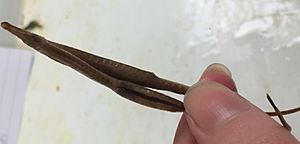Gulf pipefish facts for kids
Quick facts for kids Gulf pipefish |
|
|---|---|
 |
|
| Conservation status | |
| Scientific classification | |
| Synonyms | |
|
Siphostoma scovelli Evermann & Kendall, 1896 |
The Gulf pipefish (Syngnathus scovelli) is a fascinating fish that belongs to the same family as seahorses. It gets its name because its body is long and thin, like a pipe!
Description
The Gulf pipefish looks like a long, thin stick. Its body is covered in bony rings, almost like armor. These fish are usually brown or dark olive green. They often have shiny, white stripes along their sides, which sometimes look like the letter Y.
Most Gulf pipefish are about 10 centimeters (4 inches) long. The longest ones can reach up to 18 centimeters (7 inches). They have a short snout, which is the part of their head before their eyes.
This fish has a moderate-sized fin on its back called the dorsal fin. It stretches across several of its body rings. It also has a rounded tail fin. However, its other fins, like the anal fin and pelvic fins, are very small or missing.
Female Gulf pipefish have a special ridge on their belly called a keel. This keel is smaller in young fish and males. Adult male pipefish have a special pouch on their underside. This pouch is where they carry their eggs.
Diet
Gulf pipefish are active eaters during the day. They mainly munch on tiny sea creatures. Their diet includes small crustaceans like copepods, amphipods, and isopods.
Smaller pipefish, less than 5 centimeters (2 inches) long, mostly eat copepods. Bigger pipefish enjoy a wider variety of food. They eat more amphipods, tiny crustacean eggs, and small shrimp.
Habitat
The Gulf pipefish lives in both salty ocean water and brackish water. Brackish water is a mix of fresh and salt water, like in estuaries.
You can often find them in shallow areas near the shore. They like places with lots of plants, like clear streams and rivers that might have a tea-stained look from natural tannins. They also love to hide in seagrass beds found in estuaries.
Reproduction
Scientists don't know everything about how long Gulf pipefish live or how fast they grow. They might become adults in about six months. Most of them probably live for less than one year.
Gulf pipefish can breed in fresh, brackish, or very salty water. They can have babies all year long. However, on the northern Gulf Coast, they tend to slow down their breeding in winter.
When a male pipefish becomes an adult, he grows a special pouch on his belly. This brood pouch stays with him for his whole life. He uses it to carry the eggs.
The female pipefish starts a special dance to find a mate. The male and female swim together and bob up to the water's surface. Then, they wrap their bodies around each other.
After mating, the male rubs his brood pouch along the bottom. This helps move the eggs to the back of his pouch. The eggs are bright orange and shaped like ovals or pears. They are about 1.3 millimeters wide.
The eggs stay inside the female until they are ready to be moved to the male's brood pouch for fertilization. After about 14 to 15 days, if the water is around 24.5 degrees Celsius (76 degrees Fahrenheit), the eggs will hatch. Male pipefish are known to carry eggs from several different females at once!
Distribution
You can find the Gulf pipefish along the Atlantic coast. They live from northern Georgia, south along the Florida coast, and into the Gulf of Mexico. Their range extends even further south to São Paulo, Brazil.
Interestingly, some Gulf pipefish have been found far inland in freshwater. They've been reported in Lake St. John in Louisiana, about 150 miles from the coast. They've also been seen in Lake Texana in Texas, about 50 miles inland.
Etymology
The scientific name for the Gulf pipefish is Syngnathus scovelli.
- Syngnathus means "jaw together." This refers to how their jaws are fused.
- scovelli is named after Josiah T. Scovell. He helped collect the first samples of this fish.
See also
 In Spanish: Syngnathus scovelli para niños
In Spanish: Syngnathus scovelli para niños


